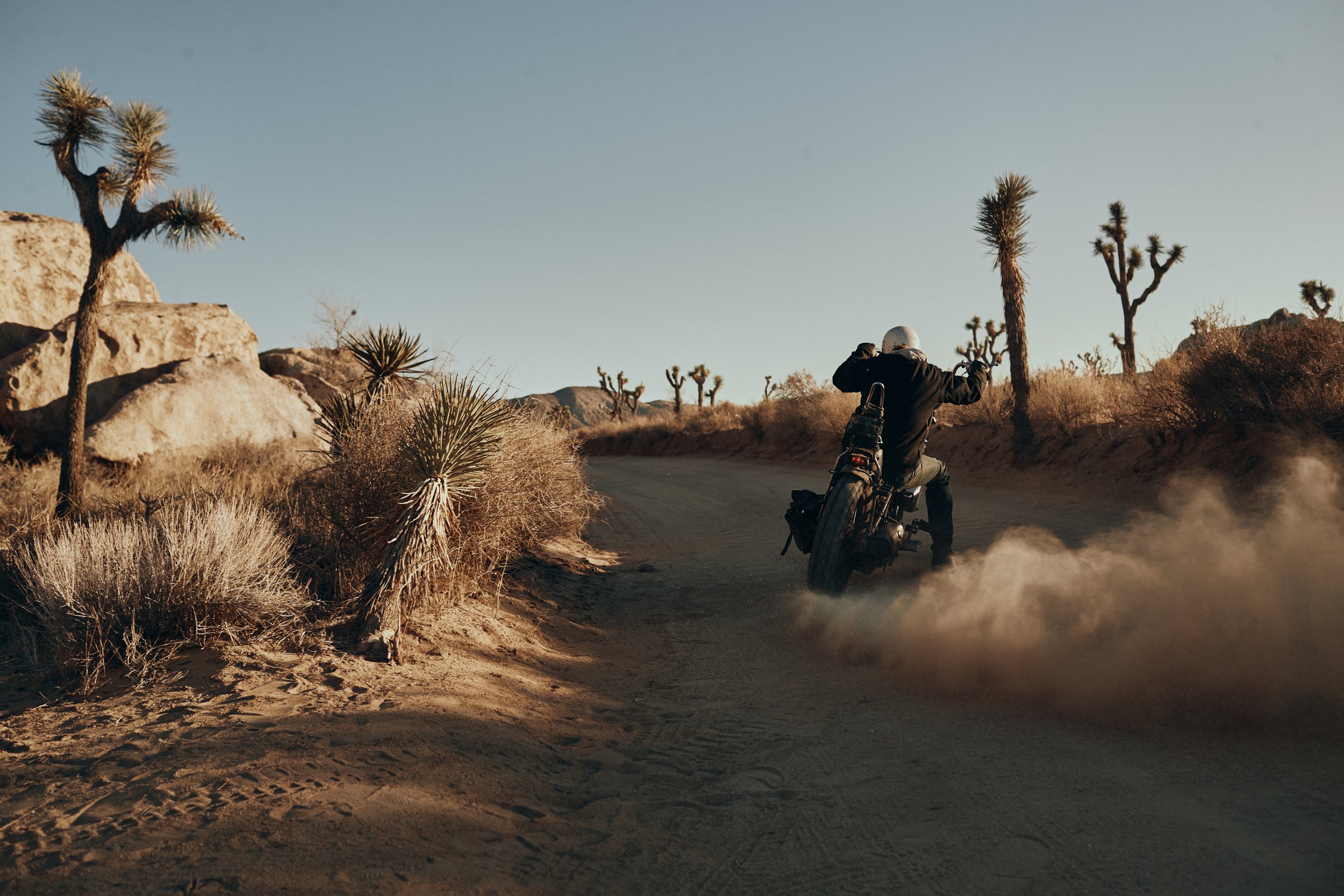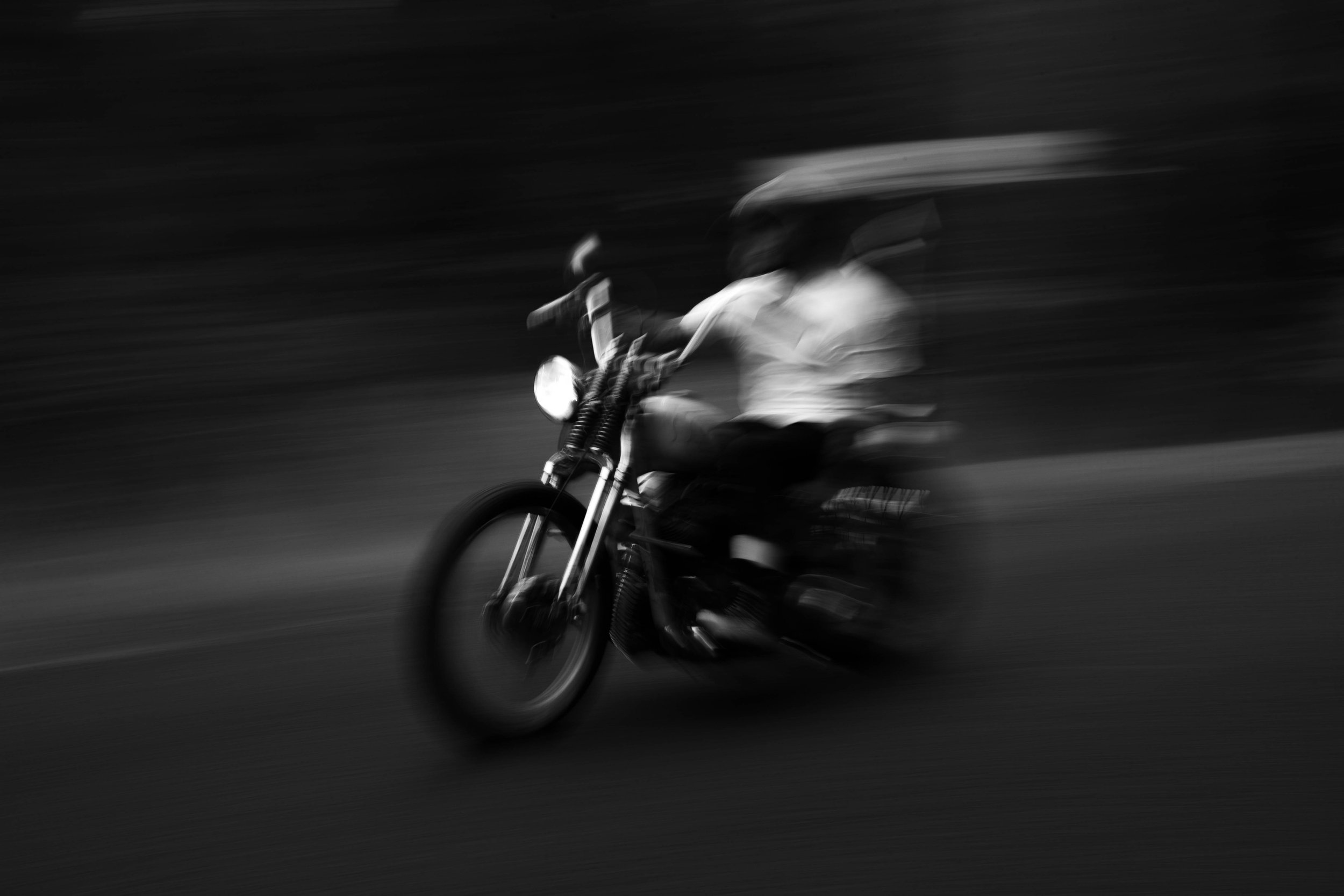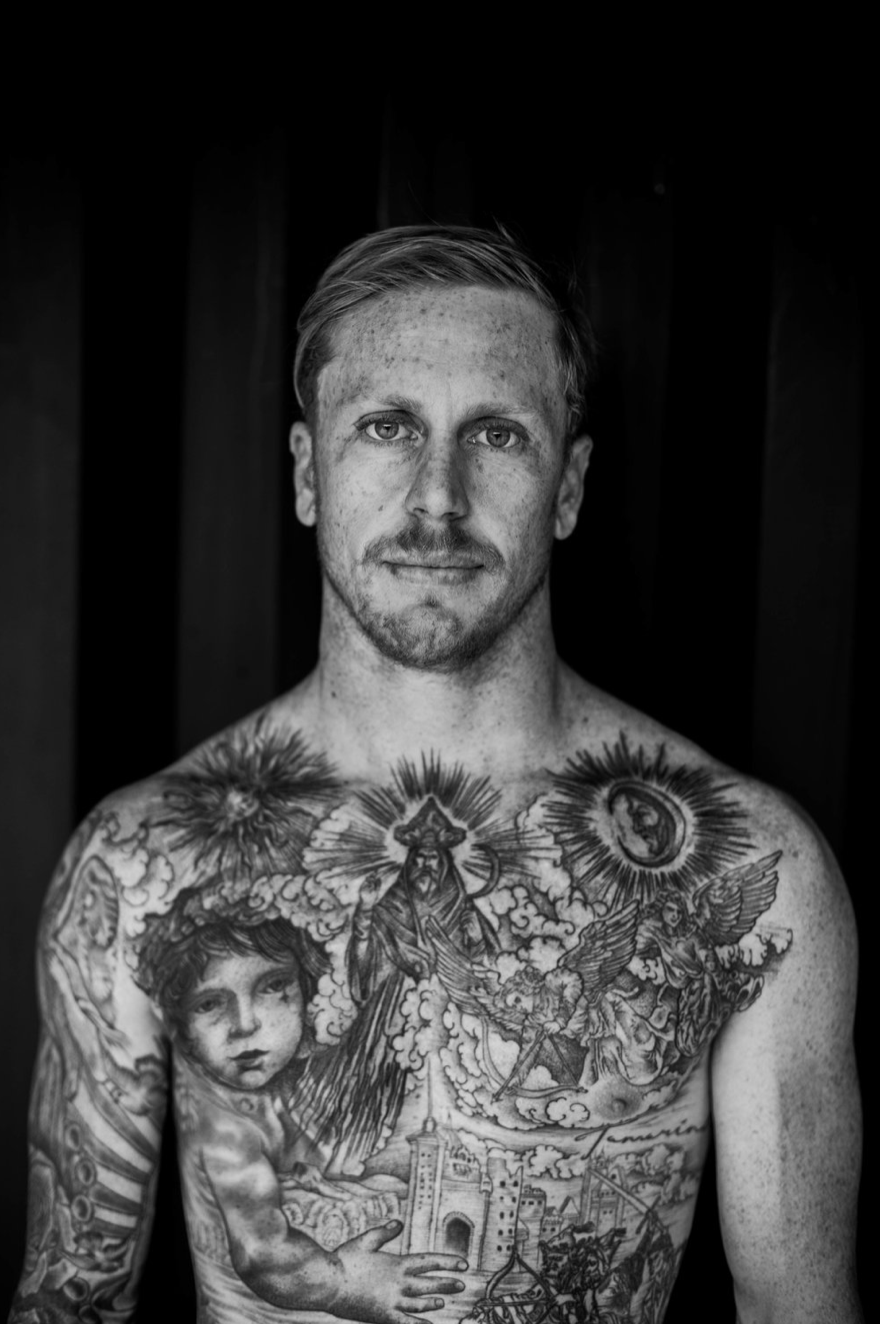RALPH DUNNING ON PURPOSE
Words by Seth Richards | Photography by John Hebert
Video by Kasen Schamaun | Directed by Ben Giese
On a motorcycle, we’re all foreigners. We don’t belong. We don’t know where we’re going. We’re in over our heads.
The mountain pass is buried in snow. The trail’s descent is ice and mud, and it’s getting colder as daylight fades in the Mojave. There’s no way out but back. As you try to turn around on the hill, you stall the engine and drop the bike. It’s the fifth time in the last hour you’ve dropped it, and it takes all your strength to pick it up. Still, nothing’s dire, you tell yourself. Your body calls your bluff. Your sympathetic nervous system kicks in without your blessing: That relentless pounding in your ears is the beat of your heart, and it feels like it’s trying to punch its way out through your earplugs.
Your heart betrays you and turns your head. You’re not a good enough rider. You’re too old. You’re not supposed to be here. This isn’t what you signed up for.
But it’s exactly what Ralph Dunning signed up for.
The 58-year-old Toronto native was riding a rented BMW R 1250 GS as part of RawHyde’s Mojave Magic Adventure, a seven-day guided tour through the California desert, when it became apparent that there are a lot of ways to feel out of place on a motorcycle.
“The whole reason I wanted to go on that trip was to address what fear means to people,” Dunning says. “But I didn’t know it was going to be super-technical, or that we’d be riding at such high speeds. You kind of go in like a deer in headlights.”
“The first big ride day, we pulled off into this pass, and it’s ten miles of really narrow and really technical terrain,” he continues. “Ten minutes in, I break my ribs. A couple minutes later, I go over the bars and smash my head. The side of my Shoei is nuked. I remember thinking, ‘I’ve just got to get out of this pass.’ And then we hit deep sand for the first time. And I’m on this huge bike. Now I’ve entered into a world of motorcycling I didn’t know existed.”
A year and a half earlier, Dunning had never even swung a leg over a motorcycle.
In life and work, Dunning is a man tirelessly in pursuit of purpose. Professionally, this quality made him a disruptor in his field and turned him into a successful entrepreneur. In 1993, after a decade working in the music industry, Dunning founded his first company, Rip N Hammer, which attempted to do for the cycling and endurance racing world what a brand like Stüssy did for the surf-and-skate world. Then, in 2001, he founded Dunning Golf and grew it into one of the foremost golf apparel brands in the world, making his name synonymous with quality and innovation.
The inspiration for the brand came when Dunning played a round of golf at a public course on the Big Island of Hawaii. He had just completed an Ironman race and found himself swinging a club, wearing a cotton shirt, absolutely drenched in sweat. He looked around the green and saw a legion of sopping cotton. By that point, he’d been designing and manufacturing technical apparel for a decade. In the golf world’s tendency toward conservatism, he saw an opportunity, despite his unfamiliarity with the culture.
Dunning developed a series of products focused on fit, performance, durability and timeless design. His approach was met with a mix of excitement and criticism. “From 2001 to 2007, no one understood what we were doing except for the tour players,” Dunning says. “They loved the fact that we were making all this technical stuff. Then, in 2007, Zach Johnson wore one of our compression pieces, our pants, our underwear, our polo, and he won the Masters. Our brand just blew up. Dunning Golf completely redefined the golf industry. It changed the entire landscape.”
Dunning continued to innovate, developing new fabrics, always with an eye toward the needs of the player. For the golf community’s love of luxurious-feeling fabrics, Dunning Golf added performance attributes from the broader sporting world: stretch, airflow and heat management, odor control, and UV protection. The golf world eventually took notice, and larger brands began to pursue the world beyond cotton, though many took shortcuts by using chemically treated fabrics that weren’t as durable, ecologically friendly, or effective as what Dunning was developing.
In 2011, Dunning sold 75 percent of his company to grow the brand globally. Even with new corporate ownership, Dunning focused on maintaining the brand’s original DNA, producing proprietary fabrics and controlling brand communication to build consumer trust.
After nearly two decades, Dunning left the brand in 2020 to follow other paths.
A year later, one of Dunning’s closest friends fell ill. His friend was passionate about learning how to ride a motorcycle, and had already bought a new Triumph, so Dunning decided he’d learn how to ride as a way to support him.
“I’ve been a bicyclist for 35 years,” Dunning says. “From a peripheral perspective, I always looked at motorcycling as dangerous and never really understood it.”
Regardless, on a wet day in October, Dunning went to a local off-road school to learn the basics of operating a motorcycle.
“I showed up and there were, like, twenty people,” he says. “Fifteen of them were like six years old, and the rest were like 12 to 15. And me.”
They put him on a Yamaha TT-R230 and introduced the absolute basics of riding. Throttle, clutch, brakes. Dunning says: “I got on the bike, the clutch goes out, and the bike starts to move, and I was like, ‘Fuck!’”
After about 45 minutes and having experienced the glorious success of shifting into second gear, Dunning followed the class around some gravel tracks. From his years of gravel biking, it all started to click, and his enthusiasm grew. After the class, when all the kids went home, the instructor took Dunning around for the rest of the afternoon. He was hooked. “I stopped at a bike dealership on the way home to buy a TT-R,” he says.
That spring, he took the M1 course to get his street license. “I didn’t really love school, but I studied for this test like it was the most important thing I’d ever done,” he says. “So, I passed the written portion and then the M2 course, and then I got a Honda CB500X. Within a year and a half, I rode 15,000 miles on it and sunk my teeth into motorcycling. Now I’m obsessed. It’s all I think about.”
When he signed up for RawHyde’s Mojave tour, he knew he’d be out of his comfort zone, exposed to terrain he’d never encountered before, riding a bike with close to three times as much horsepower as anything he’d ever ridden, and among riders with decades of experience.
“On the second day,” Dunning says, “we rode through a bunch of technical sand stuff, and I stuck with the crew and was really proud. But near the end of the day, it was getting dark, we were at really high elevation in really fast, winding sections, and I got dropped. They probably waited for me for ten minutes. When I pulled up, the ride leader was annoyed and kind of got in my face. He said: ‘Why are you so slow?’ I just looked at him and didn’t say anything and rode back to the hotel. I didn’t even know how to process that until I realized he had no idea that I was a new rider.”
“It was kind of embarrassing getting dropped like that, but I wanted to learn, and the only way to get to that point is to ride with really good riders,” he adds. “You’ve got to be around people who are better than you. There’s going to be some humiliation that goes along with that. But it’s no different from learning anything — in business or anything.”
At 55 years old, when many people look forward to slowing down and replacing work with leisure, Dunning began to develop a new brand called Foreign Rider Co., specializing in small-batch, ethically produced clothing built to his exacting standards in Toronto. The first short runs of foundational items like tees and hoodies sold out quickly, showing that there’s always a market for quality.
“The last thing the world needs right now is another apparel company,” Dunning says. “What apparel is doing to the environment is a problem. There are too many companies and harmful production processes. There’s too much shit being put into landfills. I wanted to address all of that and build a company exactly the right way.”
The brand’s logo is a basic circle with the lowercase abbreviation “fr.” inside. The logo alludes to the brand’s purpose of producing straightforward garments refined to their essentiality. Since discovering motorcycling, Dunning has reevaluated the scope of its offerings, however, and is relaunching with the mantra “the exploration of fr.eedom.”
To begin with, Foreign Rider will introduce a line of high-performance base layers that keep their shape and stay fresh even beneath a motorcycle jacket. Then, it will introduce casual wear, including Supima cotton T-shirts made from California-grown cotton that’s knit, sewn and dyed in Toronto. Selvedge denim jeans and a Halley Stevenson waxed cotton canvas jacket will follow.
“Even with T-shirts,” Dunning says, “in the back of my mind, I’m asking, ‘How does this apply to the life of someone who rides?’ We have thirty years of apparel experience, so we understand fit, fabric, construction and aesthetic. There’s a reason for every piece we make to exist. Long-lasting quality is so important to us.”
In 2024, Foreign Rider will introduce motorcycle riding gear. There are few types of clothing as technically demanding, but Dunning is undeterred, and plans on leveraging the moto community to develop gear fit for the future of riding.
Dunning is too humble to say he hopes to do for the moto world what he did for the golf world, but his ambition is evident. Foreign Rider is more than just his next business venture and a culmination of his professional expertise; for Dunning, it’s the act of motorcycling dyed, stitched together, and worn for life.
The brand is an expression of Dunning’s personal journey and of the journey of every motorcyclist: To find the heart of motorcycling, Dunning subjected himself to the unknown challenges of the Mojave.
“A few days into the Mojave tour, I’d torn my pectoral muscle, broken my ribs in two places, sprained my wrist, and almost put my knee through that boxer engine,” Dunning shares. “I was just in agony. They were like, ‘Do we need to have someone come get you?’ But I shook it off. When I thought about all the Ironman races I’d done over the years, I knew I’d be fine. I rode the rest of the trip and felt such a sense of pride that I was able to grind it out. What it did for me was address fear. This leads into Foreign Rider and our mantra of ‘the exploration of freedom.’”
Dunning knows that fear is the other side of purpose. Fear doesn’t merely stand in the way of purpose; it walks beside it hand in hand. From competing in eight Ironman races to risking financial security to pursuing new business ventures, he’s grown accustomed to fear’s heart-pounding, head-turning companionship. To know fear is to know freedom.
“Getting into motorcycling was that defining moment in my life where I opened up to what freedom actually is,” he says. “And freedom is all-encompassing — in your mind, what you do on your bike, how you communicate with people, how you open up to the world. I learned all of that from riding a motorbike. There’s a Zen-like approach to living that motorcycling has brought to me.”
Dunning says that at the same time, he was influenced by the Japanese belief that every person possesses ikigai, a latent purpose that when discovered brings meaning and fulfillment. Ikigai is achieved when a person combines what they love, what they’re good at, what the world needs, and what they can be paid to do. Life and work are viewed not as distinct or opposing forces, but as a singularity that melds passion, vocation, mission and profession. It makes an art of living well.
“For the first time in my life, I’m really comfortable with who I am as a businessperson,” Dunning says. “When Dunning Golf started to really grow, I made some tactical mistakes by letting the company grow too quickly. I saw financial opportunities and chased them before realizing I wasn’t ready. Now, I get up in the morning and believe in what I’m doing.”
Sigrid Undset, the Nobel Prize-winning author, writes in The Burning Bush: “St. Thomas had a psychological explanation even for such a thing as his feeling about work—he defined art, ars [the Latin for “skilled work”], as an intellectual virtue, and virtue in his language means power. Art is the right understanding of the thing which is to be produced; every man is a worker, and as such, has need of art, not in order to live well in a moral sense, but in order to do good work.”
Foreign Rider is in many ways the manifestation of Dunning’s ikigai and his fulfillment of Thomas’ portrayal of the worker. Motivated by his passion for two wheels, recognizing a space in the marketplace, and armed with three decades of expertise, Dunning is freed by the notion of ars-as-power and equipped to do good work.
Dunning’s work is defined by building brands with integrity. His understanding of culture gives him a zoomed-out perspective, while his goal of creating products of lasting quality keeps his focus rooted in the particulars. On the brink of relaunching Foreign Rider Co., Dunning is also planning to revive his first company, Rip N Hammer, with a focus on motocross, off-road riding, and mountain biking.
Good work is born of purpose, purpose is born of freedom, freedom is born of fear. Rather than running from fear or resting in the solace of his own success, Dunning went to the desert to embrace unknown danger, adopting a posture of humility in the pursuit of freedom and purpose.
“By the end of the trip,” Dunning says, “the instructor who was pretty hard on me at first was high-fiving me and hugging me. He had me follow him through the twisties to show me the right lines, and he took time to help me. He taught me a lot. By the end, he said: ‘Right on, man. You’re a rider now.’ With everything I’ve done in my career, that moment means more than anything.”
We’re all foreign riders. Fear finds us, and freedom takes us. In the end, we belong wherever we’re going.

























